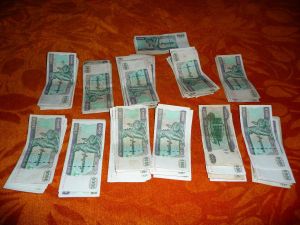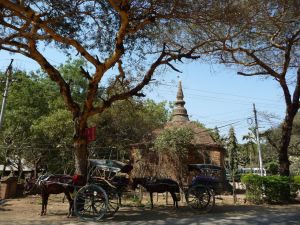Our top picks for Asia (purely subjective)
Vietnam:
Thailand / Bangkok:
Making full use of the butler service in our double suite at the Sheraton Grand in Bangkok.
North India:
Visiting the Taj Mahal in all her stunning beauty.
South India:
Getting lost among the ruins of Hampi – a totally unexpected gem in India which took our breath way.
Cambodia:
Myanmar:
Seeing monks collecting alms in Luang Prabang in the cool dawn light.
Bangladesh:
Drinking tea at the Bangladesh Tea Research Institute.
Sri Lanka:
Weird Myanmar
Money
There are two major annoyances connected to money 1) When you change money you get so much Kyat (pronounced ‘chat’), that you almost need a bag to carry it around in. Above you can see the number of bills we received when we changed 150 Euros. 2) Nobody wants to accept old, worn, crumpled, faded, dirty, written on or otherwise imperfect US $ bills. On several occasions claimed that a $20 bill we had just handed to a cashier was the last one
as they inspected it closely for imperfections, held a conference with their colleagues and finally called their boss to ask if it was OK to accept it. It was hard to understand why foreign currency needed to be perfect; the Kyat change we received was so unbelievably dirty that it made our stomachs churn to think of waiters handing us bread with the same hands that had just been gripping wads of filthy money. Many Kyat bills also appeared to have been ripped up and taped back together like this:
Third Reich Vogue
On our first day in Yangon we were surprised to see a young Burmese man wearing a black T-shirt sporting a large swastika on the front and the Reichsadler (Eagle of the Third Reich). It was such an arresting sight that we debated whether we should chase after the teenager enquire if he knew what he was wearing, but decided that we might make him relish the attention which his T-shirt had brought him.
A few days later we found ourselves waiting in a teashop for a bus to Mandalay, oddly there seemed to be a lot of people riding motorbikes sporting ‘Wehrmacht’ soldier’s helmets. One of the motorbike riders stopped at the teashop for a drink and we were able to sneak the above photo with our zoom lens. We were shocked to discover that this was not simply an uncanny resemblance, but that the Swastika and Reichsadler had been carefully stuck on to the side of the helmet as if they were a brand name.
Fairy Lights and the Disney-effect
Fairy lights seem to flash in the most unlikely places in Myanmar. They are used most often as decorations on the exterior of hotels and restaurants, but can even be found as ‘halos’ in the holiest site in Myanmar, Shwedagon. Given the frequent power cuts it seems odd that people invest so much money in these lights. In our experience, the more lights a hotel was illuminated with at night, the shabbier it was in the cold light of day.
TV and Music Videos
TV is everywhere in Myanmar: in teashops, restaurants and on buses. Even though we couldn’t understand a word, a few unfortunate seating designations caused us to be subjected to it for several hours. Programmes usually featured tragic love stories in which women cried in despair or poor slapstick, which invariably got the whole bus or teashop laughing hysterically. Alternatively, slushy music videos were played ad nauseam, featuring karokevideo-style soft focus and implausible plots, accompanied by well known western melodies that had been blatantly ‘localised’ (pirated).
We are sure that the viewers had no idea that these songs had a prior existence in English. On a serious note, it was peculiar to see that all videos showed pale skinned actors wearing Western clothes and sunglasses (not a lungi in sight!), living in palatial homes and driving luxury vehicles. The images were so far removed from reality that it could not even be called aspirational TV; the programmes were like something from another planet. Perhaps TV provides an escape, or maybe it is one more tool used by the state (which tightly controls all broadcasting); the new ‘opium of the people’.
For more information about Myanmar celebrities check: http://www.myanmarcelebrity.com/
Teashops: The best place for food, friends and a nice cuppa!
The first time I visited Myanmar I found the food absolutely awful. I remember getting cold, unappealing curries and underwhelming ‘Chinese’ noodles which lacked flavour. It was only on this trip that we discovered what I had been doing wrong…
One of the most important places for socialising in Myanmar is the teahouse. Every town, no matter how small, has at least one. The teahouse is a place to drink tea, meet friends and neighbours and to while away the hours when the sun is at its most ferocious. Teahouses also provide one of the few forums for political discussion and have traditionally one of the few places where the more daring in Burmese society exchange their opinions on the regime, albeit in the knowledge that spies lurk within. The teahouse is also one of the best places to find delicious, cheap snacks which are far more satisfying than many restaurants.
In Mandalay, we had breakfast at the city’s most popular teahouse. The curried noodles, steamed mushroom and meat filled buns and Shan noodles were accompanied by the lovely sweet milky tea which is popular throughout Myanmar. The portions were huge, the people watching opportunities endless, and the meal itself was a mere 2.5 Euros! In fact, it was so satisfying that we returned later in the day for tea and were fortunate enough to meet a Burmese couple who were tour guides. It was from them that we learned that teahouses serve as a pressure release valve for those who dare to criticise the military regime.
In Nangshwe, near Inle Lake, street food and teahouses provided the bulk of our sustenance. We feasted on samosas, which are traditionally an Indian snack, as well as eating roti (also Indian), grilled fish and barbecued meat. All of it was tasty and although at first we had some reservations about hygiene, we are happy to report that neither of us got sick.
The most notable restaurant we found in Myanmar was Aroma 2 in Bagan. Following the Lonely Planet recommendation we ate there on our first night and found the delicious Indian curries served on banana leaves (accompanied by mango chutney, mint sauce, ginger, a sort of sweet tomato salsa and dahl), so good that we simply had to return the next evening.
Fresh fruit is also abundant in Myanmar and fruit salads, shakes and lassis are to be found on almost every menu. In summary, the most important things to remember about eating out in Myanmar are: eat street food and stick to the teashops which locals frequent.
The 2100 from Mandalay to Bagan
I love trains. There is something about a long train journey that fills me with excitement; the pre-departure shopping trip for supplies, the quick shot of chai on the platform before the train departs and the endless opportunities to sample exotic treats thrust through the windows by vendors at the stations along the way. The motion of the train lulls me into a sleep so good that like a great book, which one hopes will not end, I often find myself longing for an hour or two more in the cocoon of the train as it reaches its destination.
The 2100 to Bagan was different. We had been told that it was nearly impossible to get the vendors in Myanmar to sell a foreigner an Ordinary ticket on any train. We had heard that we would be instructed to buy an Upper Class (First Class) ticket for $10 each, so it was with a sense of achievement, that we handed over $8 for two tickets on the 9 hour train ride to Bagan in the Ordinary carriage. We wanted to see how the locals really travel in Myanmar.
When we got to platform 1A, there was already a large crowd of people waiting. Mats were spread out on the floor; the atmosphere was reminiscent of a picnic as vendors weaved between the passengers hawking pomegranates, apples, cheroots and betel nut as well as various beverages. Several people sat on the edge of the platform gripped by the drama on the TV screens that were set up in restaurants across the train tracks.
When the train arrived, people gathered their belongings and got on board. We, as the only foreigners on the platform, we were directed towards Upper Class a couple of times as locals mistakenly assumed that we must have chosen to travel in a comfort. Finally we were ushered to seats 53 and 54, which were wooden, rather like a park benches. There was a small luggage rack above, as well as ample space to store our backpacks. We sat down next to the open window and waited for the train to depart as a cast of hawkers passed the window presenting goods clutched to their bosoms in baskets or piled high on their heads.
As the train pulled out of the station punctually, we remembered the conversation we had had with a couple of Australian backpackers at 5 am that morning in a dusty teashop at Mandalay bus station. They mentioned that they had met a traveller who had taken a train in Myanmar and described it as “bumpy”. That was an understatement.
As we picked up speed, the train began to literally bounce on the rails. The carriages swung wildly in opposite directions and the train seemed as if it were going to spring off the rails on which it was travelling. It was like riding a bucking bronco at the rodeo! We had read about a couple of nasty derailments on trains in Myanmar in recent times and can now say that we are not at all surprised! Sleeping was challenging; everyone, young and old, began headbanging involuntarily to the jerking motion of the train and the seats made deep impressions on our buttocks. A tangle of bodies formed at our feet; those who were determined to sleep took to the floor.
Our carriage was occupied by a group of drunk, teenaged boys, who were shouting and singing wildly. The commotion continued as we wrestled clutches of sleep throughout the night. A further impediment to sleep was the toilet, which lacked lighting and began to reek, as a steady succession of passengers hit, but most frequently missed, the hole in the floor. The lock on the toilet door did not work, so the powerful stench of human waste wafted through the carriage as the door slammed constantly throughout the night.
The cacophony of sounds emitted by the dinosaur train’s rumbling and jolting combined with the screeching of metal, made it the most unforgettable train trip either of us have ever had. At one point, I was jogged awake violently and began laughing to myself – the laughter of someone who is on the edge of insanity. I began thinking that words could not adequately describe the horror of the journey. We would have videoed it if there had not been so many men in uniforms around.























